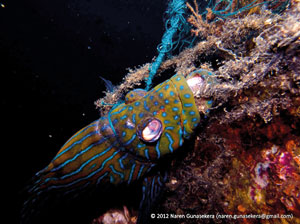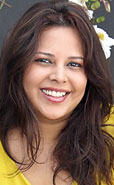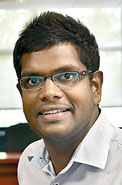The story behind the photo
View(s):Determined not to create just another ‘photo blog’ the founders of ‘The Picture Press’ marry the images on their site with narrative text to provide a more valuable experience for the viewer
By Smriti Daniel
This week, we meet the three founders and curators of The Picture Press (www.picturepress.org). Anushka Wijesinha is a research economist and hobbyist photographer, Iromi Perera is a researcher and social pollster as well as a theatre producer and Aarthi Dharmadasa is a programme officer in the Sri Lankan operations of an international mine action agency.

A blue-line grouper dangles in a fishing net.Pic by Naren Gunasekera
Under the tagline ‘the write side of photography’, The Picture Press is an ambitious, beautiful site designed to showcase photographs that are placed firmly in their context by an accompanying narrative text. Designed by Joe Lenora and We Are Designers, it took Anushka, Aarthi and Iromi pooling their own funds to launch it, but it is now up and running, with the curators welcoming submissions from amateurs and professionals alike.
Excerpts from our interview:
What’s the backstory? Why did the three of you decide to pitch in to create The Picture Press ?
Anush: Shahidul Alam, is the short answer! In January 2012 the three of us were at a talk by renowned Bangladeshi photojournalist and activist Shahidul Alam on the sidelines of the Colombo Art Biennale. The work he is doing is trailblazing for South Asia. We realised that more Sri Lankans need to do more with their photographs – write narratives, raise awareness, and talk about issues – through their images. That began the conversation among the three of us about creating an amateur photojournalism platform online.
Aarthi: The three of us have different yet similar interests in how photographs communicate. I am particularly interested in how people respond to the photographs and why…
Iromi: I also think that people, especially young people, need to engage with more serious issues that we are experiencing at present, whether it is the environment or political, because they affect all of us. It’s not always easy to get people to engage on serious issues and I think photographs are a great way to get a conversation started.
Why accord the narrative as much weight as the picture itself?
Anush: Captions and narratives really bring context to an image and add value to the experience of the person looking at the image…So, bringing in the writing, the journalism, into photography – hence the name, The Picture Press.
Aarthi: We didn’t want to be just another photo blog…The narratives are icing to an already delicious cake. It is the beginning of TPP’s “conversation.”
Iromi: Photographers are great storytellers – who else would be better at explaining what compelled them to take the pictures that they do, why they think certain issues/ people/ events they photograph are important or even what the story behind a particular photograph is…it’s like asking someone to write a short essay of sorts about a particular issue but using their own photographs as a starting point.
As curators, what kind of submissions would you like to see?
Anush: I think the first thing is that the photographers themselves need to be passionate about using their images for something more. That’s where it begins…Submissions that talk about social, economic, political, cultural issues that have wider relevance and interest – that’s what we are looking for at The Picture Press.
 Aarthi |
 Anush |
 Iromi |
Aarthi: …Also, while current affairs often dictate content – I would like to see submissions in topics that are silent, or only spoken about during their commemoration days.
Iromi: I would love to see photographs that show how diverse “development” can be. When people think of development they immediately think of high rise buildings, roads and bridges. Development is so much more than that and it is also open to interpretation. Post war Sri Lanka is a very different place to what it was even three years and I think it’s important to document the changes the country is undergoing.
Why the focus on development, did it follow naturally from your professional interests?
Anush: Well, the reality is that in Sri Lanka we have very different understandings of what development is and different people have different ways of engaging with the issue…So why not through photographs, giving people an extra way to engage with the issue of development?
Aarthi: My short answer is “Yes!” Development covers many many issues and it is large enough for us to set our context in.
Iromi: I know that it’s sometimes hard to get people understand the gravity of certain issues through text so TPP is very accessible that way to get conversations started or to raise awareness on issues.
Follow @timesonlinelk
comments powered by Disqus


















